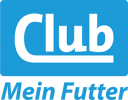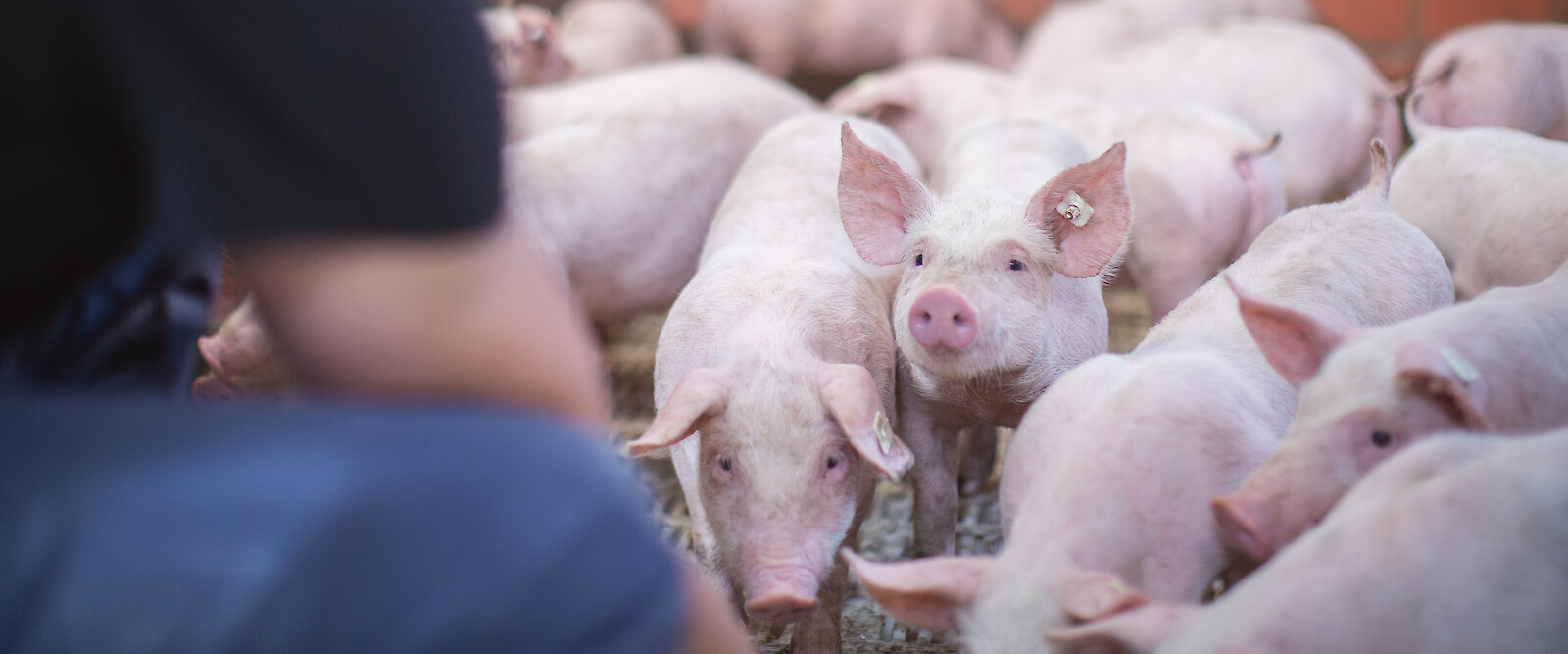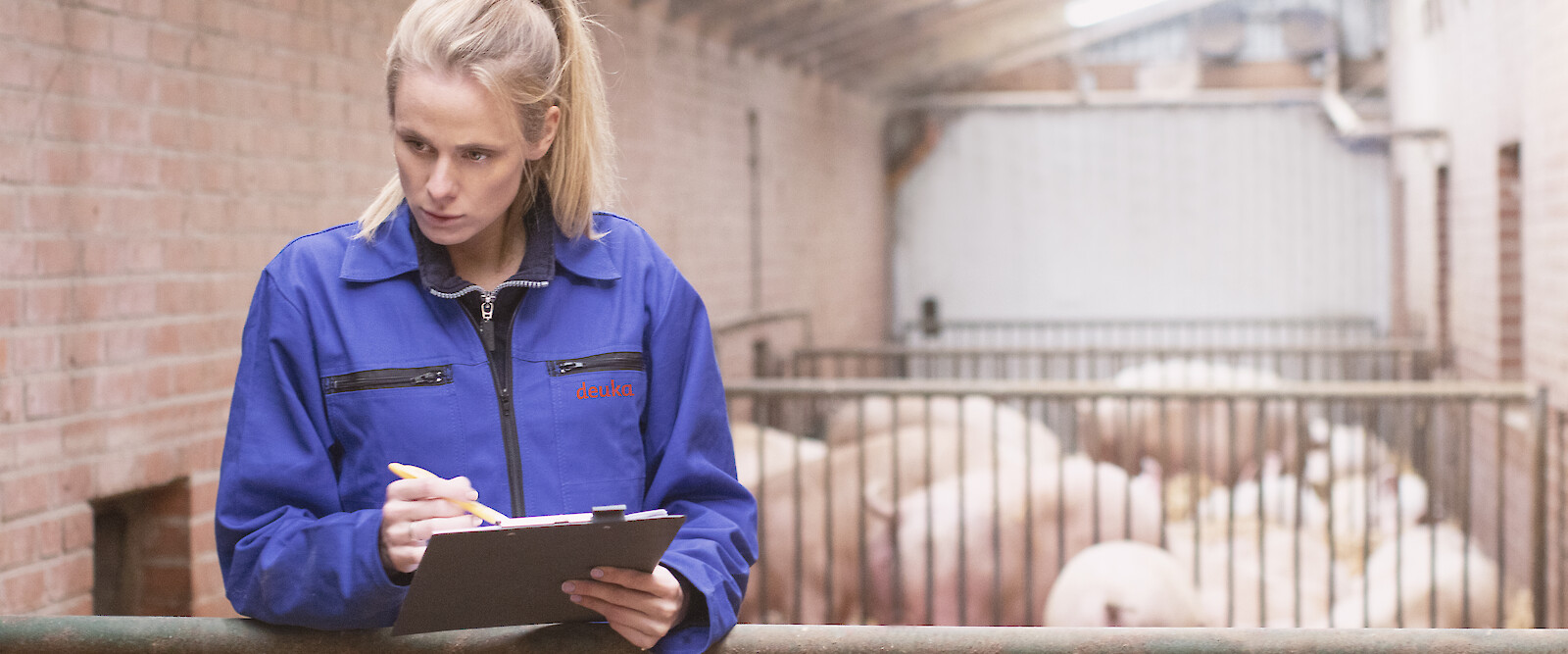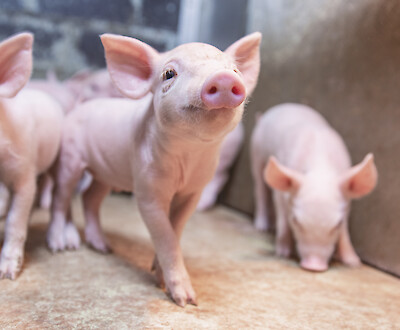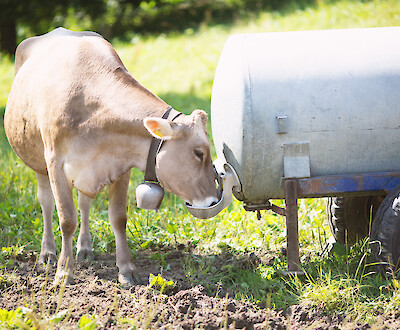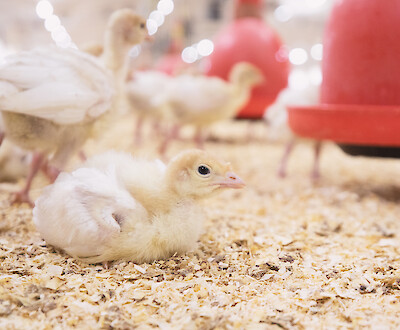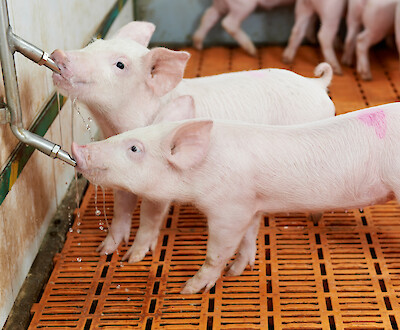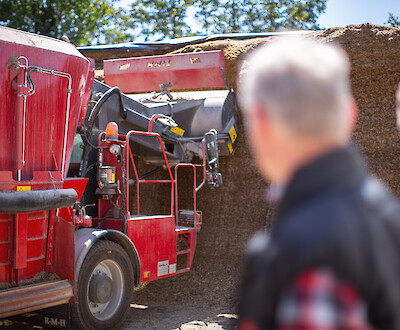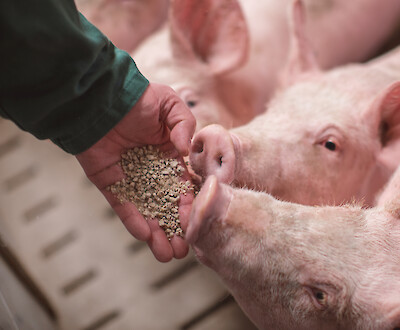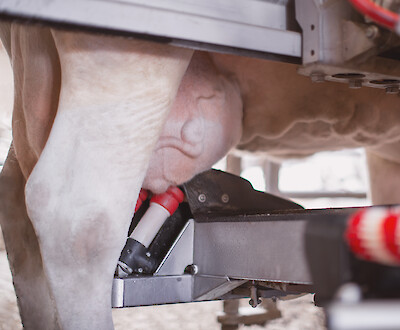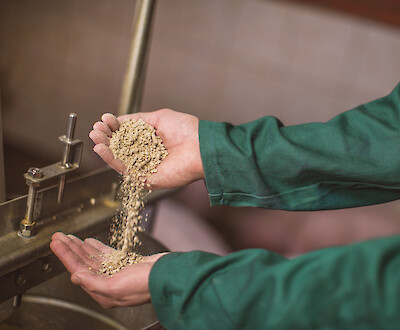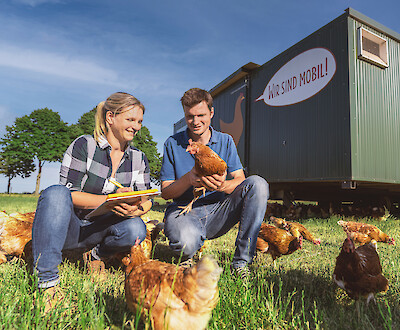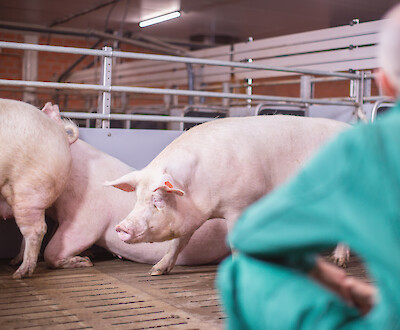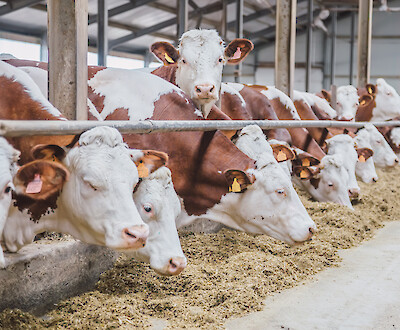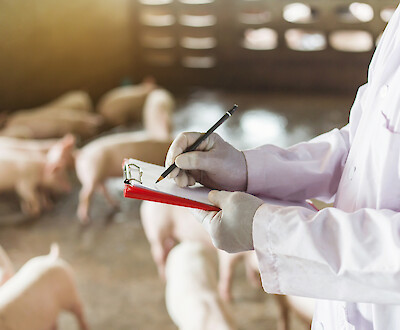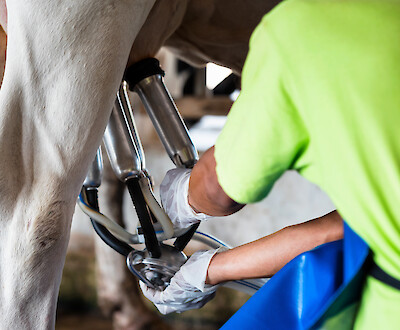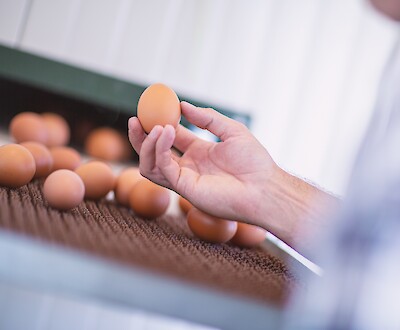Self-mixing: ensuring supply to pigs in line with demand
Characteristics of modern mineral feeds for fattening pigs, sows and piglets
In order to balance the rations of their sows, piglets and fattening pigs, home-breeders must add mineral feed to their own and purchased basic feed components. High-quality mineral feeds provide pigs with all essential vitamins, minerals and trace elements. The use of free amino acids and enzymes also improves the digestibility of the total ration. However, the needs of pigs vary depending on the animal and its stage of life. A modular and easily adaptable mineral feed concept is therefore required for optimal supply.
In order to design rations for fattening pigs, sows and piglets that meet their needs, three groups of feeds are usually used:
- Farm-grown grains as sources of energy, protein and fiber (e.g., wheat, barley, rye, triticale),
- Protein sources (e.g., canola and soybeans, but also peas and field beans),
- Mineral feed.
The combination of cereals and protein sources alone is not sufficient to create a balanced ration in line with requirements. For this, farmers must compensate for the deficiencies of the basic feedstuffs with the help of mineral feeds. In addition to bulk and trace elements, these contain vitamins (especially vitamin A, vitamin D3 and vitamin E) and essential amino acids (primarily lysine, methionine, threonine and tryptophan, and in some products also valine), which the animals need in their daily feed to achieve their performance potential.
Common ingredients of mineral feeds
| Bulk elements | Trace elements | Vitamins | Additives |
| Calcium | Copper |
Vitamin A |
Amino acids |
| Phosphorus | Zinc | B vitamin complex | NSP enzymes |
| Sodium | Manganese | Vitamin D | Phytases |
| Magnesium | Selenium | Vitamin E | Probiotics |
| Vitamin K | Acids | ||
| Toxin binders |
Ration calculation: Prerequisite for the exact use of mineral feeds
A prerequisite for the targeted balancing of the ration with the aid of a mineral feed is a ration calculation. The basis for this is an examination of all the individual feedstuffs used. Nutrient analyses of the basic or straight feeds (e.g. at LUFA Nord-West) can be used to calculate the feed mixtures. This is the condition for the choice of a suitable mineral feed. This is the only way to create a balanced ration for pigs that is appropriate to their needs and performance. Your feeding advisor at Deutsche Tiernahrung Cremer will be happy to advise you.
Analyze feed quickly, easily and cost-effectively
With our practical LUFA analysis tool, you can quickly and easily create test orders for the analysis of your farm's own basic feedstuffs. As part of the joint project in cooperation with the Agricultural Research Institute (LUFA) North-West, you can choose from three different analysis packages. Place your test order now and benefit from great discounts.
Characteristics of high-quality mineral feed concepts for pigs
Regardless of the specific requirements that fattening pigs, sows and piglets place on "their" mineral feed, modern mineral feed concepts (e.g. deukaMin) have some basic, common characteristics.
-
High-quality componThe raw materials used in mineral feed, whether straight feed (e.g. calcium carbonate or additives such as phytases) must be supplied by certified manufacturers in consistently good quality. At the same time, the goods must always be dry and free of impurities or hygiene defects. Finally, the structure of the components used must not be too fine or too coarse so that the feed segregates as little as possible.
-
Vitamine und Spurenelemente sind für zahlreiche Stoffwechselvorgänge sowie vielfältige immunologische und enzymatische Reaktionen verantwortlich. Das Optimum in der Versorgung liegt exakt dort, wo Mangelerscheinungen verhindert und Überdosierungen vorgebeugt werden. Die fettlöslichen Vitamine A, D, E und K und die wasserlöslichen B-Vitamine werden in Mineralfuttern bedarfsorientiert zugesetzt, um die Ration für eine optimale Leistung auszustatten. Kupfer, Eisen, Selen, Mangan, Jod und Zink als Spurenelemente vervollständigen ein gutes Mineralfutter.
-
Animal welfare and sustainability are of utmost importance in pig farming. When designing rations, pig farmers must therefore ensure that they supply the animals with all the nutrients they need. By using synthetic amino acids, the amino acid pattern of the total ration can be optimally adapted to the animals' needs. This avoids protein surpluses and reduces nitrogen excretion. Highly effective enzymes such as phytases and NSP enzymes break down molecules in the feed that are indigestible for the animal, thus releasing the nutrients bound in them. In this way, the animals can utilize them better and fewer nutrients end up in the slurry. Excess phosphorus can thus be avoided (read more in our current article). Finally, probiotics also make a valuable contribution to the utilization of nutrients by supporting the intestinal flora and predigesting fiber components.
-
Especially the mineral components (e.g. calcium) can be a dusty affair. To ensure that the mineral feed is nevertheless as low in dust as possible, it makes sense to add oil or molasses. This binds the fine components and at the same time prevents segregation and ensures a homogeneous feed.
-
In Germany, almost exclusively QS pigs are slaughtered in the slaughterhouses. For this, these pigs must also have been fed with QS-certified or QS-recognized goods.
Mineral requirements differ depending on the animal and feeding objective.
The requirements for bulk and trace elements, vitamins and amino acids differ greatly between fattening pigs, sows and piglets. Depending on the life situation and feeding objective, the specifications for ingredients and quantity ratios in the mineral feed therefore also varied.
Optimal body condition for parturition and for subsequent milk production is important in sows. The pregnant sow must also receive sufficient nutrients for the embryonic growth of the piglets through the feed. The better the supply, the more consistent and higher the average weight of the piglets in the litter. To ensure this, mineral feeds for pregnant sows must have a balanced supply of amino acids. In the low-bearing phase (days 1-84 of gestation), the feeding recommendation is 14.6 g of lysine, and in the high-bearing phase (days 85-115), 20.4 g per animal per day.
However, sow farmers should also ensure a moderate calcium and phosphorus supply with the help of the gestation mineral. Too high a calcium content and a calcium/phosphorus ratio above 2:1 reduce the utilization of phosphorus and magnesium as well as a number of trace elements. On the other hand, an excessively high phosphorus supply and a narrow calcium/phosphorus ratio leads to demineralization of the bones. The supply recommendations for pregnant sows are 6.0 g calcium and 4.5 g phosphorus per kilogram of feed. An adequate supply of vitamins keeps the animals' metabolism and immune system stable. Vitamin E in particular can help prevent fetal death in the early stages of pregnancy. The German Agricultural Society (DLG) and the Society for Nutritional Physiology (GfE) recommend at least 15 International Units (I. E.) of vitamin E per kg of feed for a supply that meets requirements. However, the levels in common mineral feeds are usually much higher to take advantage of the antioxidant effect of vitamin E. Vitamin E protects cells from the influence of free radicals and thus prevents their harmful effect on the organism.
After farrowing, sows need to get back to eating quickly. Only in this way are they able to produce sufficient milk to supply their piglets and quickly regain their strength after the strenuous birth. Mineral feeds for sows in the suckling phase should therefore contain a safety supplement to meet the increased requirements resulting from high milk production, strong growth of the piglets and natural fluctuations in the ingredients of the basic feeds. Highly available calcium sources (e.g. calcium formate) are also used in high-quality sow mineral feeds. In this way, the body's own mobilization of the mineral from the bones can be kept to a minimum and the sow has sufficient calcium available for milk production.
The use of L-carnitine is also useful in the suckling phase. The vitamin-like substance transports fatty acids to the site of processing and thus promotes more effective energy utilization. As a result, milk yield increases, which promotes rapid piglet gain. The sows must not over-seed during lactation, which is why the use of synthetic amino acids is mandatory for muscle maintenance and milk production.
On-farm feeds are usually used for the first time after weaning of the piglets. Weaning and the - in most cases associated - new housing means stress for the young animals. Stress in turn reduces growth, leads to immunosuppression and ultimately increases susceptibility to diseases (e.g. diarrhea). To cope with the changeover, a piglet supplement is used after weaning (30-50% of the total piglet ration), which contains milk components and other highly digestible components (e.g. digested cereals).
From about twelve kg live weight, piglets also receive a ration consisting of various basic feed components and a mineral feed. The piglet mineral feed not only provides all the essential components for a balanced ration, it also safeguards this by adding acid. Piglets are not yet able to produce sufficient gastric acid, which serves to acidify the feed slurry and activate protein digestion. Various acids such as formic, lactic or fumaric acid or their salts are used in the ration. Other safety components in mineral feeds include probiotics, which positively influence the microflora in the small intestine and thus reduce pathogen attachment to the intestinal wall.
In addition, additives such as phytases and NSP enzymes are indispensable in modern mineral feeds for piglets. In order to increase the digestibility of the feed with the help of these enzymes, legal minimum dosages must be observed. NSP enzymes in particular reduce the viscosity of the feed slurry in the intestine by digesting non-starch polysaccharides - of which the animals are otherwise incapable. The resulting "more fluid" intestinal contents improve the overall utilization of the nutrients in the feed, as the enzymes are thus better able to reach their site of action.
In the feeding of fattening pigs, the focus is on growth and a high meat content. Mineral feeds can support this and ensure that the ration is adequately supplied with amino acids. At the same time, the protein content of the total ration can be reduced and nutrient management improved. The phytases contained in mineral feeds optimize phosphorus utilization and thus reduce the animals' P excretion. As a result, animals excrete less excess nitrogen unused. NSP enzymes also ensure (as in piglets) better digestibility of nutrients and higher energetic utilization of feed components.
Fattening pigs also need sufficient calcium for stable bone growth and skeletal development that keeps pace with meat gain. The calcium required for this must be supplied to them in sufficient quantities via a mineral feed. The recommendations are 7.0 g of calcium per kg of feed for pre-fattening, 6.0 g for mid-fattening and 5.5 g for finishing.
deukaMin: Modern mineral feed concept for pigs
The deukaMin mineral feed concept is aimed at farmers of fattening pigs, sows and piglets. All deukaMin feeds have a balanced mineralization and vitaminization. By using the latest generation of phytase, the mineral feeds also ensure high phosphorus availability from the farm's own components. With high synthetic amino acid content, they promote rapid growth and optimize meat set. In addition, non-starch polysaccharide-splitting (NSP) enzymes improve overall feed conversion.
For more information on the realignment of our deukaMin concept, click here.
Conclusion
- A balanced ration consists of farm-grown cereals, protein sources (e.g. rapeseed, soy) and mineral feed.
- It always starts with a ration calculation based on the nutrient analysis of all individual feed components.
- The ingredients of sow, piglet and fattening pig mineral are based on the animals' needs and the respective feeding objectives.
- Common characteristics of high-quality mineral feed concepts are: high-quality and easily digestible components, a needs-oriented composition, a homogeneous mixture and QS certification.
- deukaMin is such a modern mineral feed concept for pigs.
Further information
- Supply recommendations for energy, crude protein, amino acids and minerals from the Thuringian State Institute for Agriculture (german).
- Information on mineral contents and requirements in nitrogen- and phosphorus-reduced feeds in "DLG-kompakt" (german).
- General information on "mineral feeds" in the "FutterFakten" section of the German Pet Food Association (DVT) (german).
Contact person

Contact person

